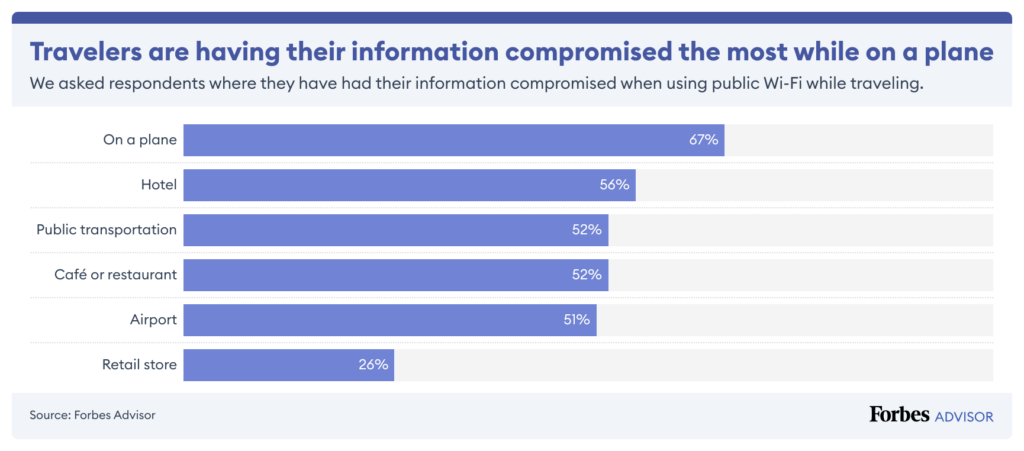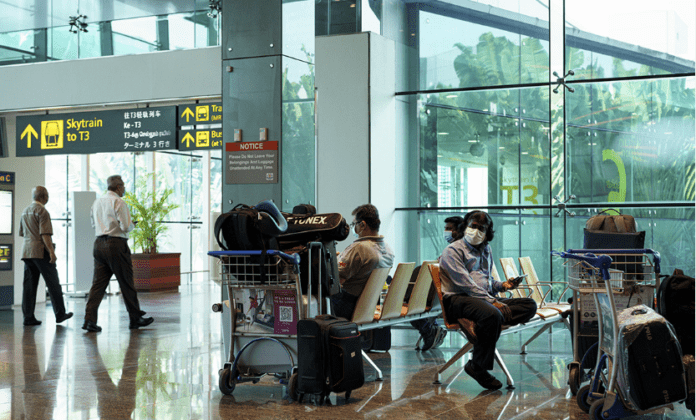As the holiday travel season picks up, so does the usage of public Wi-Fi networks for travelers to stay connected while lounging in airports, hanging at the hotel, and enjoying time at their favorite cafes. While cybersecurity attacks increase around the holidays, and especially while people travel, Americans must keep their data safe from cyberattacks while using insecure networks.
Forbes Advisor found that 41% of travelers have had their information compromised on public Wi-Fi while traveling in the last year.
A new study from Forbes Advisor revealed that 85% of travelers are concerned about having their digital information stolen while traveling. With 67% reporting they’ve had information stolen while using public Wi-Fi on a plane.

Highlights from our report:
- Only 17% of travelers report feeling unsafe while using public Wi-Fi networks, even though 4 in 10 have had their information compromised while using public Wi-Fi.
- Hotels and public transportation pose significant cybersecurity risks when traveling, with 54% and 53% respectively reporting having their information stolen while using public Wi-Fi.
- Travelers are using public Wi-Fi despite the risk—even though 59% say public Wi-Fi is risky in an airport, 39% still use it. While 73% feel like public Wi-Fi is risky in a hotel and 47% still choose to use it.
- More than half of travelers use public Wi-Fi to stream content, use social media, or cut down on their cellular data usage.
Forbes Advisor surveyed 1,000 Americans who regularly use public Wi-Fi and have traveled in the last year to understand the risks they’ve experienced while using public Wi-Fi networks.
How is information stolen on Public Wi-Fi?
Information can be stolen on public Wi-Fi networks through various methods, often referred to as “Wi-Fi hacking.” Here are some common techniques used by attackers:
1. Man-in-the-Middle (MITM) Attacks: In this type of attack, an attacker intercepts the communication between your device and the Wi-Fi network. They can then eavesdrop on your data or even alter it without your knowledge. This is possible because public Wi-Fi networks usually lack proper encryption and authentication protocols.
2. Evil Twin Attacks: Attackers create rogue networks with names similar or identical to legitimate Wi-Fi networks. When users connect to these fake networks, all their traffic passes through the attacker’s device, providing access to sensitive information such as passwords, emails, and credit card details.
3. Packet Sniffing: Hackers use software tools to capture and analyze network traffic passing through a public Wi-Fi. By examining these data packets, they can extract personal information and login credentials transmitted over the network.
4. Malware Injection: Attackers can inject malware into public Wi-Fi networks, which, when accessed by unsuspecting users, can infect their devices. This malware can then gather sensitive information and send it back to the attacker.
To protect yourself from such threats while using public Wi-Fi, consider the following precautions:
– Avoid connecting to unsecured Wi-Fi networks whenever possible.
– Use a virtual private network (VPN) service to encrypt your internet traffic and make it more secure.
– Disable automatic Wi-Fi connections on your devices to prevent accidentally connecting to malicious networks.
– Make sure your devices have updated security software and firewalls installed.
– Limit your online activities while connected to public Wi-Fi, especially avoiding accessing sensitive information like banking or email accounts.
– Use websites with HTTPS encryption whenever possible, as it provides an additional layer of security.


